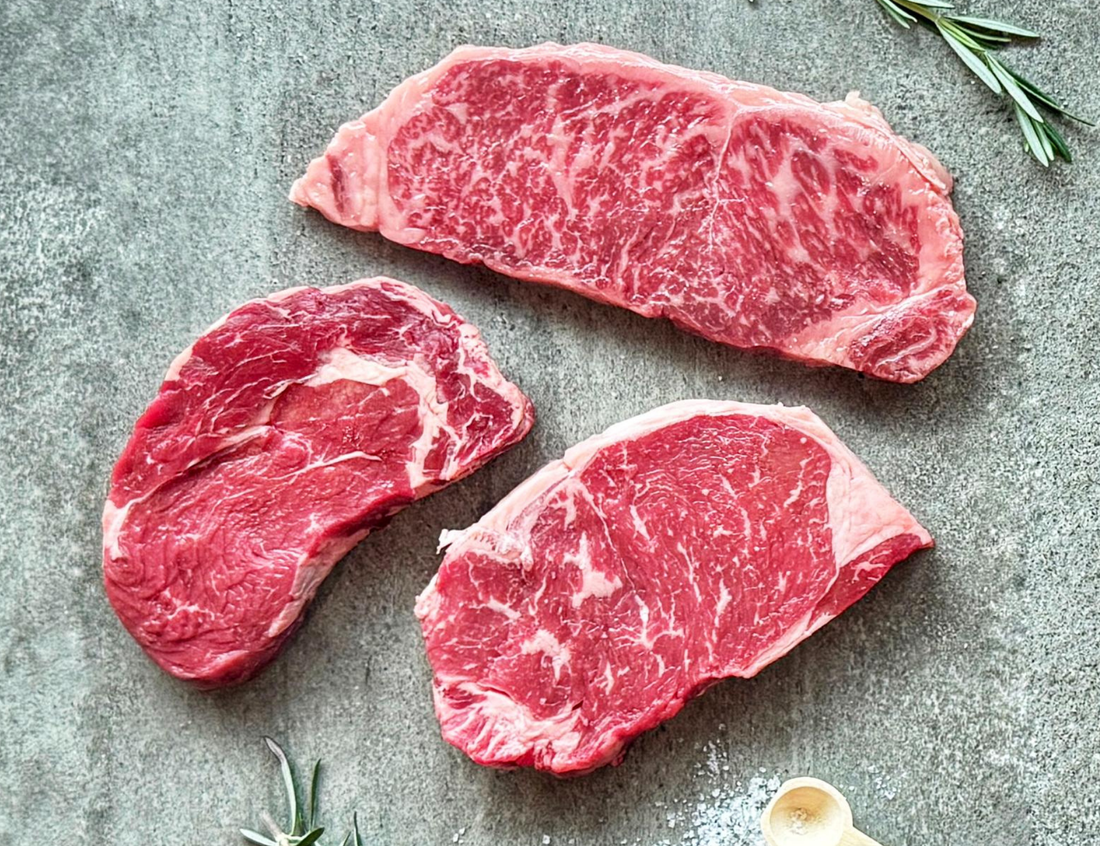When browsing the butcher counter or shopping online for premium meat, you’ll likely come across labels like grass-fed beef, grain-fed beef, corn-fed beef, or even Wagyu. But what do these actually mean? And how do they affect flavour, tenderness, and cooking results?
In this definitive guide, we’ll explore the different types of beef, help you understand the nutritional and culinary differences, and highlight which ones are best for your needs. Whether you’re preparing for a BBQ, a family roast, or a luxurious steak dinner, this guide will help you choose the perfect cut.
Grass-fed Beef: Nature’s Flavour Profile
Grass-fed beef comes from cattle that have grazed on natural pasture throughout their lives. This method of raising cattle results in a noticeably different product compared to grain-fed or corn-fed beef.
Key Traits:
-
Lean and firm texture
-
Darker red colour
-
Pronounced, natural beef flavour
-
Less marbling (intramuscular fat)
-
Higher in Omega-3s and antioxidants
Best For:
-
Health-conscious eaters
-
Those who enjoy a robust, grassy beef flavour
-
Recipes like roasts, stews, and steak salads
-
Everyday enjoyment without breaking the bank
-
Shoppers looking for a more affordable, quality beef option
Nutritional Advantages
Grass-fed beef is generally lower in total fat compared to grain-fed beef, and studies suggest it contains higher amounts of Omega-3 fatty acids, vitamin E, beta-carotene, and conjugated linoleic acid (CLA). These nutrients may contribute to reduced inflammation and improved heart health. Grass-fed meat also tends to have a more favourable Omega-6 to Omega-3 ratio compared to grain-fed beef. From an environmental perspective, pasture-based systems may promote biodiversity, reduce reliance on grains, and contribute to healthier soils and carbon sequestration.
Recommended Brands:
-
King Island
-
Little Joe
-
Clayton’s
Grass-fed beef is perfect for those seeking healthy beef options with more natural flavour and lean protein.Note: These grass-fed brands reflect a commitment to animal welfare and sustainability. The cattle are 100% grass-fed for life, never grain-finished, and raised entirely on open pasture-ensuring traceability, ethical standards, and authentic grass-fed quality.

Grain-fed Beef: The Classic Choice
Grain-fed beef is finished on a diet that typically includes energy-dense feeds such as soy, barley, and wheat. This high-energy feed promotes marbling, which delivers tenderness and a more buttery texture.
Key Traits:
-
More marbling
-
Whiter fat
-
Tender bite
-
Milder beef flavour
Best For:
-
Those who enjoy a classic beefy flavour
-
People who prioritise tenderness with every bite
-
Everyday meals where consistency and juiciness matter
Angus Beef: A Popular Grain-fed Variety
Angus cattle are known for their strong genetics and a natural ability to develop marbling. In Australia and the US, Angus beef is often grain-finished to enhance tenderness and flavour. This is also where marbling scores start to play an important role-Angus beef is commonly assessed using marble score grading to measure intramuscular fat and ensure consistent eating quality. It's a versatile and dependable choice for both chefs and home cooks.
Recommended Brands:
- Tender Valley
- Portoro
Grain-fed beef is a great everyday option for consistent tenderness and beefy flavour.
Note: There's a common misconception that grain-fed cattle never eat grass, but that’s not true. Nearly all cattle, including grain-fed ones, start their lives on pasture, grazing on grass for the first several months. It’s only in the final stage of their lives-called the finishing phase that grain-fed cattle are moved to a feedlot and transitioned to a high-energy grain-based diet. This phase helps boost marbling and tenderness, but doesn’t mean the animal never consumed grass.

Wagyu Beef: The Luxurious Grain-fed Option
Wagyu is almost always grain-fed, but it stands apart due to its unique breed characteristics and is consistently marketed by breed. Originating from Japan, Wagyu cattle are genetically predisposed to develop intense marbling and deliver unmatched richness and tenderness.
What Makes It Special:
-
Extreme marbling (MB4/5–MB9+)
-
Melt-in-your-mouth texture
-
Unparalleled buttery richness
Wagyu cattle are raised with extraordinary care, often receiving longer feeding periods and stress-free environments. This dedication results in exquisite tenderness and umami-packed flavour-and of course, comes at a higher price.
Best For:
-
Special occasions
-
Premium dining experiences
-
Smaller servings or tasting menus
-
Quick sear or shabu-shabu
Recommended Brands:
- W. Black
- Blackmore
- Stoneaxe
Wagyu beef is ideal for those seeking an indulgent, premium beef experience.
Note: There’s an important distinction between fullblood and crossbred Wagyu. Fullblood Wagyu (e.g. Stoneaxe & Blackmore) are 100% genetically pure and traceable to Japanese lineage, prized for producing the most intense marbling and luxurious texture. Crossbred Wagyu (e.g. W. Black), such as F1 or F2 Wagyu-Angus hybrids, combine Wagyu genetics with other breeds-typically Angus to enhance carcass yield and consistency, while still delivering excellent marbling and flavour.

Corn-fed Beef: The Prime American Favourite
Corn-fed beef is typically finished on a corn-heavy diet, often comprising 70–90% of their total feed during the final months. This feeding regime is particularly common in the United States and contributes significantly to the beef's marbling and tenderness.
Key Traits:
-
Bright cherry-red meat
-
Yellow-hued fat
-
Rich and sweet flavour
-
Tender and juicy texture
Best For:
-
American-style BBQs
-
Grilled sirloin or ribeye
-
A flavourful alternative to the typical options commonly found in Singapore
Cooking Tip:
Corn-fed beef’s fat content makes it perfect for high-heat grilling. Aim for a crisp crust and medium-rare centre.
Recommended Brand:
- Linz Heritage Angus
Corn-fed beef offers a juicy, sweet profile and superb tenderness, perfect for fans of American steakhouse flavours.

Understanding the Differences: A Side-by-Side Comparison
| Attribute | Grass-fed | Grain-fed | Corn-fed | Wagyu |
|---|---|---|---|---|
| Flavour | Natural, pronounced | Milder, beefy | Sweet, rich | Buttery, umami |
| Tenderness | Lean, firmer | Tender | Very tender | Extremely tender |
| Marbling | Low | Moderate | High | Extremely high |
| Colour | Dark red | Lighter red | Cherry red | Pale pink, marbled |
| Best For | Health, bold taste | Everyday meals | BBQs, indulgent | Special occasions |
Choosing the Right Beef for Your Cooking Style
For Grilling:
-
Wagyu ribeye for indulgent richness or Grain-fed Angus striploin for classic beefy tenderness
-
Use high heat, minimal seasoning
For Stews & Braising:
-
Grass-fed chuck or brisket
-
Long, slow cooking develops deep flavour
For Weeknight Dinners:
-
Grass-fed or Grain-fed tenderloin, ribeye, or sirloin
-
Quick, reliable, and full of flavour
For Impressing Guests:
-
Wagyu tenderloin or high-marble ribeye/sirloin
-
Keep it simple: salt, pepper, medium-rare
Regional Differences in Beef Production
Australian vs American Wagyu
Both Australian and American Wagyu use Japanese genetics and are typically grain-finished to produce rich marbling. In many cases, crossbreeding is used in both countries-often with Angus cattle to balance marbling with yield, resulting in very similar eating quality.
Europe’s Protected Origins
European breeds like Chianina (Italy) and Charolais (France) are prized for leanness and heritage focusing on traditional feeding and husbandry methods.
South American Grass-fed
Beef from Argentina or Uruguay is typically grass-fed and appreciated for its rich, savoury flavour. Its reputation is built on natural, pasture-raised systems that prioritise open grazing and minimal intervention.
Beef Labelling: What Should You Look For?
Marbling Score (MBS)
Especially relevant for Wagyu, the Marbling Score (MB or MS) indicates the level of intramuscular fat present in the meat. In Australia, MS9+ represents the highest grade in the AUS-MEAT system, denoting exceptional marbling and premium eating quality.
Breed & Origin
Look for labels that specify both the cattle breed (e.g. Angus, Wagyu) and origin (e.g. King Island, Queensland, USA) for quality assurance.
Hormone-Free / Antibiotic-Free
Australian and some US beef producers offer clean, antibiotic and hormone-free meat options. These aren’t always labelled, so ask your butcher.
Common Myths About Beef Types
Myth: Wagyu is always better than Angus
Not necessarily - top tier Angus can outperform mid-grade Wagyu in flavour and tenderness.
Myth: Grass-fed beef is always tough
It can be tender if cooked properly. It’s leaner, so low and slow cooking or medium-rare searing is key.
Myth: Corn-fed beef is unhealthy
Corn-fed beef does have more fat, but this can enhance juiciness and flavour. It’s all about balance and moderation.
Myth: American beef is full of hormones
Not all American beef contains artificial hormones. While some conventional US producers use growth promotants to enhance growth rates and feed efficiency, these are regulated and must be cleared from the animal's system before slaughter. This "withdrawal period" ensures that any residues fall below strict safety limits. Many premium producers voluntarily avoid hormone use altogether, offering hormone-free beef options. Always check labels or ask your butcher to confirm the production method.
Final Thoughts: What’s Best for You?
Each beef type has its strengths:
-
Grass-fed for health, earthiness, and lean protein
-
Grain-fed for classic tenderness and everyday cooking
-
Corn-fed for rich, juicy indulgence
-
Wagyu for special occasions and ultra-luxury
At the end of the day, the best beef is the one that suits your taste and cooking style. Don’t be afraid to experiment with different cuts and cooking methods to discover your favourites.
Ready to explore? Shop Butcher Box now for the best selection of grass-fed, grain-fed, Wagyu and corn-fed beef in Singapore.

